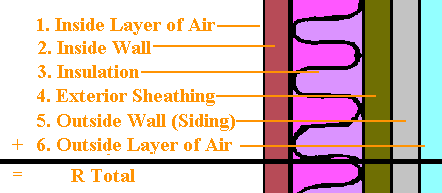Exterior Wall Insulation
- GOAL:
- To understand the necessity of reducing energy cost.
- OBJECTIVE:
- The student will learn the insulation values associated with different materials used on exterior walls.
- LESSON / INFORMATION:
- Insulation has the ability to store heat which slows down the amount of time it takes heat to move through the wall. The insulation value of the wall materials and their thickness determines heat flow in the wall.
- The insulating properties of a material is measured in R-Values. The R-Value is the measure of resistance to heat flow. The higher the R-Value, the more of a barrier it is to heat penetration.
- The total R-Value for a wall can be found by adding the R-Value of each type material used in the wall. Even a thin film of air on the interior and exterior of the wall has some insulation value.

- The table below lists some building materials and their R-values for a one-inch thickness.
| Material |
|
R-Value/inch |
| Foams (rigid boards) |
3.6 - 7.5 |
| Cellulose (loose blown) |
2.8 - 3.8 |
| Perlite (Conc. blk. fill) |
2.5 - 4.0 |
| Rockwool (batts) |
2.8 - 3.7 |
| High Density Fiberglass (batts) |
3.2 - 3.5 |
| Fiberglass (batts or blown) |
2.2 - 3.2 |
| Vermiculite (conc. blk. fill) |
2.4 - 3.0 |
| Plywood |
1.25 |
| Softwoods |
1.25 |
| Wood Siding |
.79 |
| Concrete Blocks |
.58 |
| Gypsum Board - 1/2" |
.45 |
| Brick |
.20 |
| Concrete |
.08 |
| Stucco |
.02 |
| 1/4" Wood Paneling |
.31 |
| 1/2" Dryvit |
.04 |
- ACTIVITY 1:
- Two types of brick veneer walls are shown below. Each material is listed with its actual R-Value. Add the R-Total for each wall and compare.


- ACTIVITY 2:
- Four different types of wall construction are shown below. Find the R-Total for each type and compare. Which is most effective?
- 1.

- 2.

- 3.

- 4.

- RECOMMENDED READING:
- Sweet's Catalog File, 1990, McGraw Hill
- E. Mazria, The Passive Solar Energy Book, Rodale Press, 1979.
- E. Cazayoux, A. Hebert & D. Winn, Natural Louisiana Architecture, Louisiana Department of Natural Resources, Baton Rouge, Louisiana, 1991.
- "Insulation" Fact Sheet, U.S. Department of Energy, 1980.
- TEACHER'S NOTES
- (Exterior Wall Insulation, 4" & 6" Studs)
- Answers to Activity 1:
| 1. |
| Inside Air Film |
( 0.68) |
| 1/2" Drywall |
( 0.45) |
| 3-1/2" Batts |
(11.00) |
| 3/4" Rigid Ins. Board |
( 4.00) |
| Airspace |
( 0.97) |
| Brick |
( 0.90) |
| Outside Air Film |
( 0.17) |
| Total R-Value: |
(18.17) |
| 2. |
| Inside Air Film |
( 0.68) |
| 1/2" Drywall |
( 0.45) |
| 5-1/2" Batts |
(19.00) |
| 3/4" Rigid Insl. Bd. |
( 4.00) |
| Airspace |
( 0.97) |
| Brick |
( 0.90) |
| Outside Air Film |
( 0.17) |
| Total R-Value: |
(26.17) |
- Answers to Activity 2:
| 1. |
| Inside Air Film |
( 0.68) |
| Wood Paneling 1/4" |
( 0.31) |
| 1/2" Plywood |
( 0.62) |
| 3-1/2" Batts |
(11.00) |
| 1/2" Rigid Insul. Bd. |
( 2.70) |
| Wood Siding |
( 0.40) |
| Outisde Air Film |
( 0.17) |
| Total R-Value: |
15.88 |
| 2. |
| Inside Air Film |
( 0.68) |
| 1/2" Drywall |
( 0.45) |
| 5-1/2" Batts |
(19.00) |
| Gyp. Sheathing |
( 0.45) |
| Stucco |
( 0.20) |
| Outside Air Film |
( 0.17) |
| Total R-Value: |
20.77 |
| 3. |
| Inside Air Film |
( 0.68) |
| 1/2" Rigid Insulation |
( 2.70) |
| 3-1/2" Cellulose |
(13.00) |
| 1" Rigid Insulation |
( 5.41) |
| Wood Siding |
( 0.40) |
| Outside Air Film |
( 0.17) |
| Total R-Value: |
22.36 |
| 4. |
| Inside Air Film |
( 0.65) |
| 1/2" Drywall |
( 0.45) |
| 5-1/2" Cellulose |
(20.42) |
| 1" Rigid Insulation |
( 5.41) |
| Dryvit System |
( 0.04) |
| Exterior Air Film |
( 0.17) |
| Total R-Value: |
27.17 |
Comments or questions to: TechAsmt@LA.GOV
Return to Construction and Design Menu






